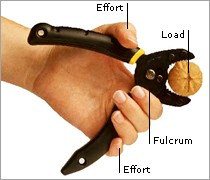DK Science & Technology: Machines
From can openers to cranes, machines make work easier. Simple machines include LEVERS, PULLEYS, INCLINED PLANES, and GEARS. They transfer force and movement from one place to another, often magnifying the force or the movement at the same time.
The mechanical advantage of a machine is the amount that it magnifies (increases) a force to overcome a load. Nutcrackers have a mechanical advantage of about five. The force you use to squeeze the handles is magnified five times—making it strong enough to crack even the hardest nut.
The efficiency of a machine is the ratio of the work output to the work input. If the machine is perfect, then all the work (energy) that you put in (the effort) is used to move the load. It would be 100 percent efficient. In reality, a machine always wastes some energy as a result of friction between its parts.
A lever is a rod or bar that turns on a pivot (the fulcrum). The effort applied at one place moves a load at another place via the fulcrum. There are three different types of levers, each with the effort, load, and fulcrum in different places.
The three classes of levers are suitable for different jobs. In a first-class lever, such as a seesaw, the effort and load are on opposite sides of the fulcrum. In a second-class lever, such as a bottle opener, the fulcrum is at one end, the effort at the other, and the load in between. In a third-class lever, such as chopsticks, the fulcrum and the load are at either end, with the effort in between.

These pliers are a pair of first-class levers. The fulcrum is between the load and the effort. The effort is magnified because the load is closer to the fulcrum.
The steering wheel of a car works like a circular lever—it magnifies a turning force. Your hands on the wheel move through a much larger distance than the axle (the steering column). The turning effort is magnified to produce enough force to steer the car wheels. A crank is a turning handle that works in a similar way, to raise a heavy bucket of water up a well, for example.
A pulley is a grooved wheel that a rope or belt runs over. A single pulley changes the direction of a force, without changing its size—for example, to raise a flag up a pole by pulling down on the rope.
A block and tackle is two sets of pulleys linked by a single rope. Pulling the rope draws the block and tackle together. This magnifies the effort put in so that you can lift or lower a heavy load—a car engine, for example. Block and tackle pulley systems have been used for centuries to raise sails and shift cargo on sailing ships.
The first construction machine was probably the inclined plane. Early builders raised loads such as blocks of building stone by pushing them gradually up a slope. The more gradual the slope, the easier it is to raise the load, but the farther you have to travel to get to the top.
When you push a load up a slope, the weight of the load is shared between your effort and the slope. You do not have to lift the whole weight at once. However, although the effort is smaller, the distance moved is greater. If you climb a zigzag path up a mountain, each step is easier, but you take many more steps to reach the top than if you follow a steeper but more direct route to the top.
A wedge is a movable inclined plane. As it is pushed forward, it pushes a load sideways. The sharper the wedge, the farther it has to be pushed to produce the same sideways movement, but the greater the sideways force it applies. The blade of an ax is a wedge that produces a splitting force as it cuts into hard materials, such as wood, rock, or ice.
Gears are toothed wheels that transfer turning motion and forces from one place to another, such as from a car engine to the car wheels. The gear teeth mesh (fit together) so that as one gear turns, it forces its neighbor to turn in the opposite direction.



